|
Ⅶ.(C)CONSCIENTIOUSNESS:3——Low |
Description of high scores:You work toward goals in a disciplined, dependable fashion. You proceed in a linear, sequential manner, with a strong will to achieve. You typically consolidate your time, energy and resources in pursuit of your goals.
Description of average scores:You tend to keep work demands and personal needs in balance. You can switch from focused activities to spontaneous diversions.
Description of low scores:You tend to approach goals in a relaxed, spontaneous, open-ended way. Your mind can switch tracks on the run. You may be a procrastinator or viewed as casual about responsibilities or unorganized.
|
|
|

C1(COMPETENCE)3——Low
Competence refers to the sense that one is capable, sensible, prudent, and effective. High scorers on this scale feel well-prepared to deal with life. Low scorers have a lower opinion of their abilities and admit that they are often unprepared and inept.
C2(ORDER)4——Average
High scorers on this scale are neat, tidy, and well-organized. They keep things in their proper places. Low scorers are unable to get organized and describe themselves as unmethodical.
C3(DUTIFULNESS)4——Average
High scorers on this scale adhere strictly to their ethical principles and scrupulously fulfill their moral obligations as they understand them. Low scorers are more casual about such matters and may be somewhat undependable or unreliable.
C4(ACHIEVEMENT STRIVING)3——Low
Individuals who score high on this facet have high aspiration levels and work hard to achieve their goals. They are diligent and purposeful and have a sense of direction in life. Very high scorers, however, may invest too much in their careers and become workaholics. Low scorers are lackadaisical and perhaps even lazy. They are not driven to succeed. They lack ambition and may seem aimless, but they are often perfectly content with their low levels of achievement.
C5(SELF-DISCIPLINE)4——Average
High scorers are able to begin tasks and carry them through to completion, despite boredom or other distractions. They can motivate themselves to get the job done. Low scorers procrastinate in beginning chores and are easily discouraged and eager to quit.
C6(DELIBERATION)3——Low
Deliberation reflects the tendency to think carefully before acting. High scorers on this facet are cautious and deliberate. Low scorers are hasty and often speak or act without considering the consequences. At best, low scorers are spontaneous and able to make snap decisions when necessary.
|
Ⅷ.Stability of Profile
Research suggests that the individual’s personality profile is likely to be stable throughout adulthood. Barring catastrophic stress, major illness, or therapeutic intervention, this description will probably serve as a fair guide even in old age.
Ⅸ. Personality Style Graphs
Broad personality factors are pervasive influences on thoughts, feelings, and actions, and combinations of factors provide insight into major aspects of people’s lives, defining what can be called personality styles. For example, for many years psychologists have known that interpersonal interactions can be conceptualized in terms of a circular ordering or circumplex, defined by the two axes of Dominance and Love, or by the alternative axes of Extraversion and Agreeableness. These two factors define a Style of Interactions.
The nine other pairs of factors also define styles, and all ten are represented in NEO Style Graphs. In each graph, there is a red right triangle, and the angle triangle is the position of the respondent, which is located where the bevers is located, and the description of the quadrant is applied to the respondent.
1. If the horizontal side of the triangle is far from the green square, the description may be the most accurate.
2. If the triangle is completely in the green square, then there is no description that is specifically related.
3. If the horizontal axis is located near the horizontal axis or vertical axis, the description of the quadrants of the axis is applicable.
Style of Well-Being
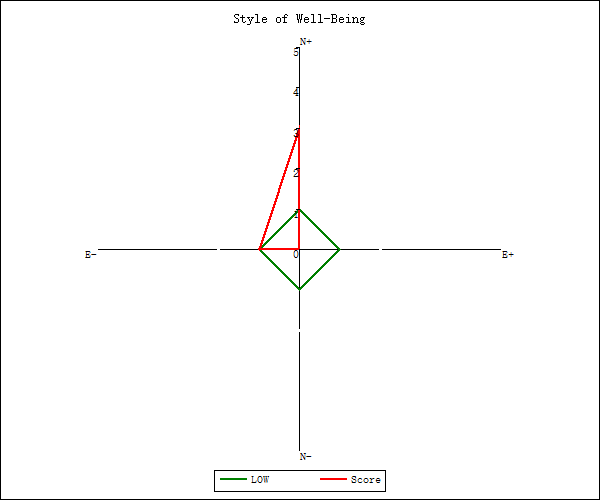
N+E-
Gloomy Pessimists
These people face a dark and dreary life. There is little that cheers them and much that causes anguish and distress. Especially under stressful circumstances, they may succumb to periods of clinical depression, and even when they are functioning normally,they often find life hard and joyless.
Style of Defense
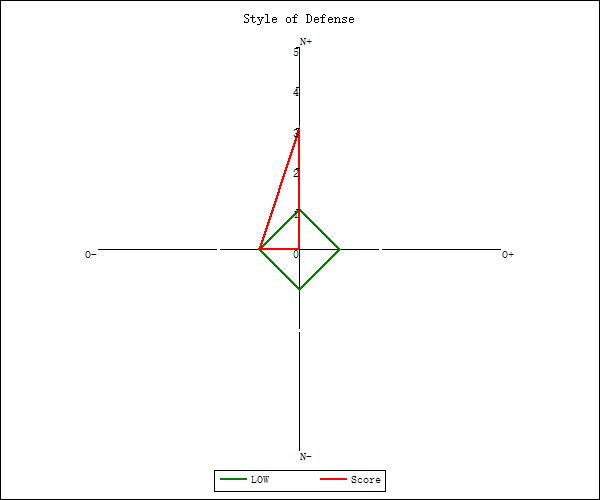
N+O-
Maladaptive
Maladaptive individuals tend to use primitive and ineffective defenses such as repression, denial, and reaction formation. They prefer not to think about disturbing ideas, and they may refuse to acknowledge possible dangers (such as a serious illness). They lack insight into the distressing affects they experience, and because they cannot verbalize their feelings, they may be considered alexithymic.
Style of Anger Control
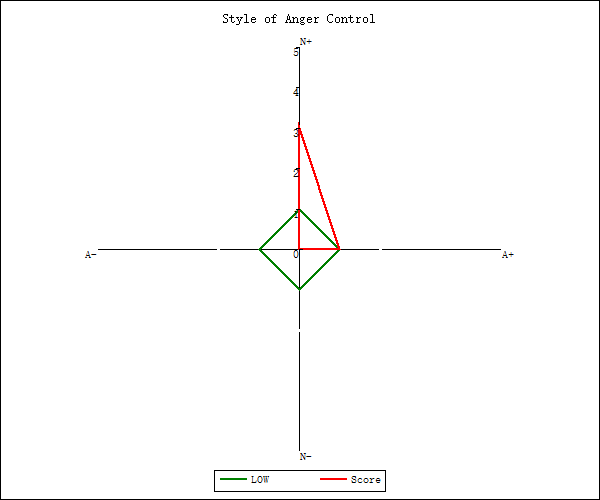
N+A+
Timid
Timid people are heavily conflicted over anger. On the one hand, their feelings are readily hurt and they often feel victimized. On the other, they are reluctant to express anger because they do not want to offend others. Their anger may be directed inward against themselves.
Style of Impulse Control
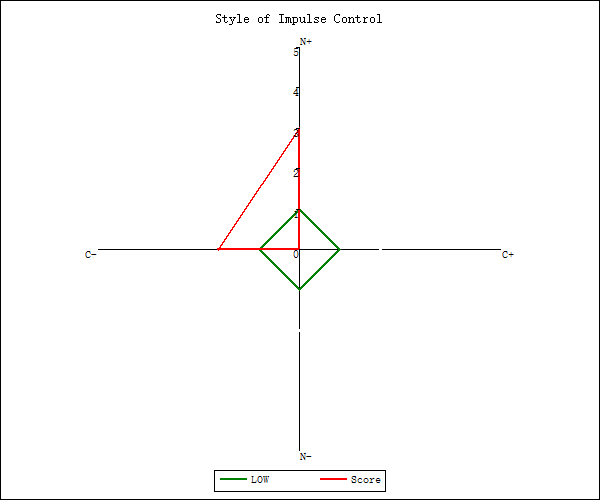
N+C-
Undercontrolled
These individuals are often at the mercy of their own impulses. They find it difficult and distressing to resist any urge or desire, and they lack the selfcontrol to hold their urges in check. As a result, they may act in ways that they know are not in their long-term best interests. They may be particularly susceptible to substance abuse and other health risk behaviors.
Style of Interests
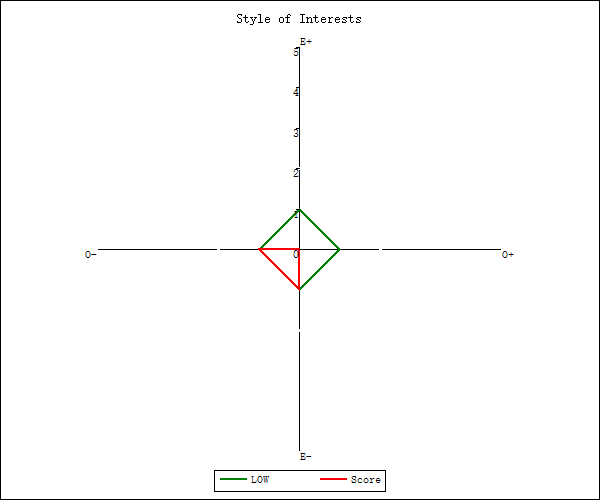
E-O-
Homebodies
Their interests are focused on activities they can pursue alone or with a small group. They are unadventurous and may collect stamps or coins, watch television, or garden. Their vocational interests may include mechanical or domestic work. Possible vocation: Bookkeeper
Style of Interactions
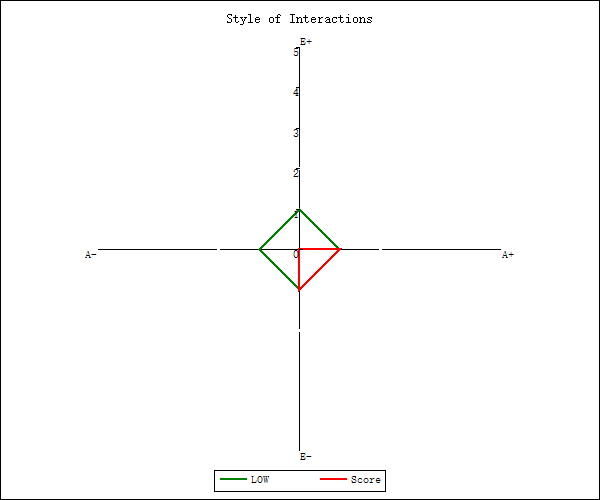
E-A+
The Unassuming
These people are modest and selfeffacing. They often prefer to be alone, but they are also sympathetic and respond to others’ needs. Because they are trusting, others may sometimes take advantage of them. Their friends should watch out for their interests but still respect their privacy.
Style of Activity
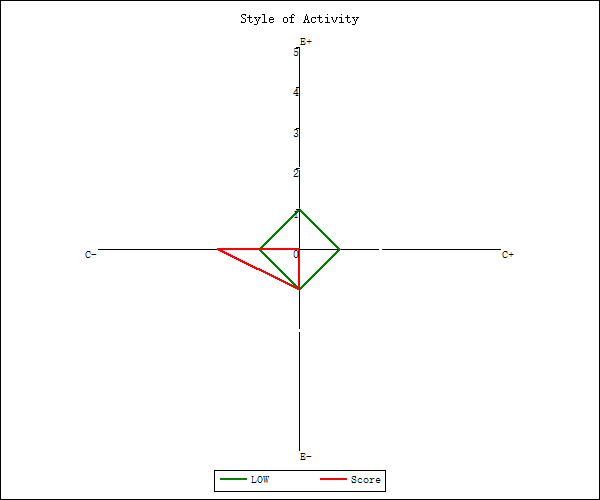
E-C-
The Lethargic
They are unenthusiastic and have few plans or goals to motivate them. They tend to be passive and respond only to the most pressing demands. They rarely initiate activities, and in group activities and games they often find themselves left behind.
Style of Attitudes
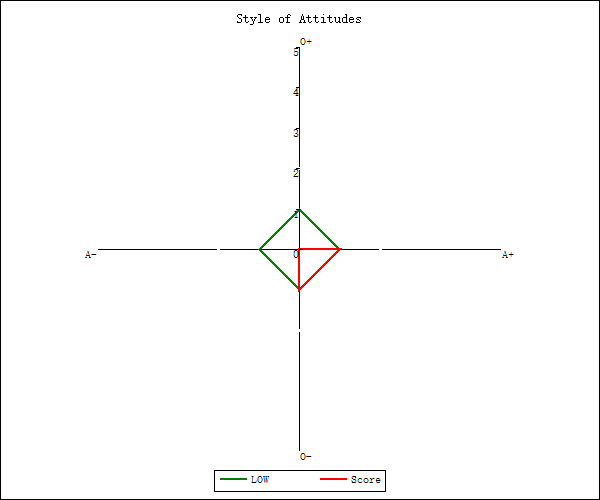
O-A+
Traditionalists
These individuals rely on the values and beliefs of their family and heritage in seeking the best way for people to live. They feel that following the established rules without questions is the best way to ensure peace and prosperity for everyone.
Style of Learning
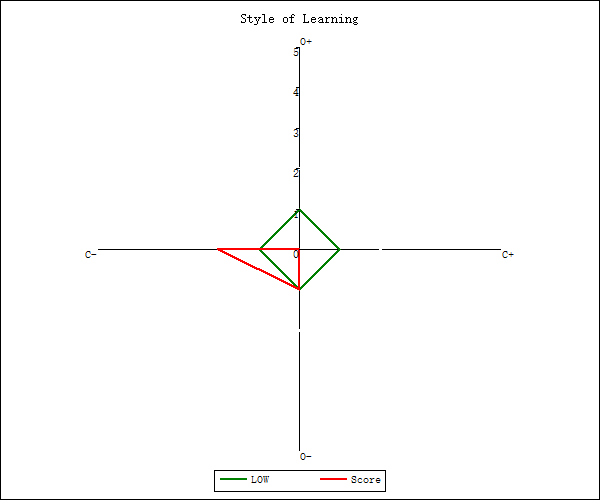
O-C-
Reluctant Scholars
Academic and intellectual pursuits are not their strength or preference. They need special incentives to start learning and to stick with it. They may need help in organizing their work and reminders to keep them on schedule. They may have problems maintaining attention.
Style of Character
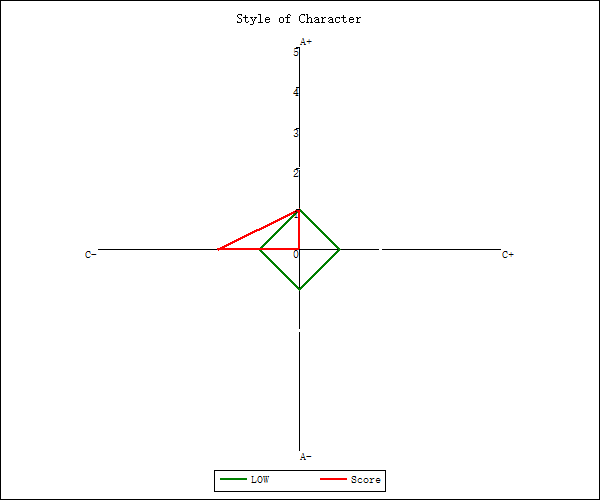
A+C-
Well-Intentioned
They are giving, sympathetic, and genuinely concerned about others. However, their lack of organization and persistence means that they sometimes fail to follow through on their good intentions. They may be best at inspiring kindness and generosity in others.
Ⅹ.NEO Personal Insight Report: Work Style
The analysis of your results is organised over four main sections: ‘Problem-solving and decisionmaking’, ‘Planning, organising and implementing’, ‘Style of relating to others’ and ‘Personal style’.
⑴Problem-solving and decision-making
In this section, we consider your approach to solving problems and making decisions. The questionnaire you completed does not assess your intellectual power (in other words, it does not assess your mental ability, or IQ as it is sometimes referred to) but it does provide insights into how you approach problem-solving and decision-making. In other words, we are talking here about your thinking style.
|
①Effectiveness at organising thoughts |
|
|
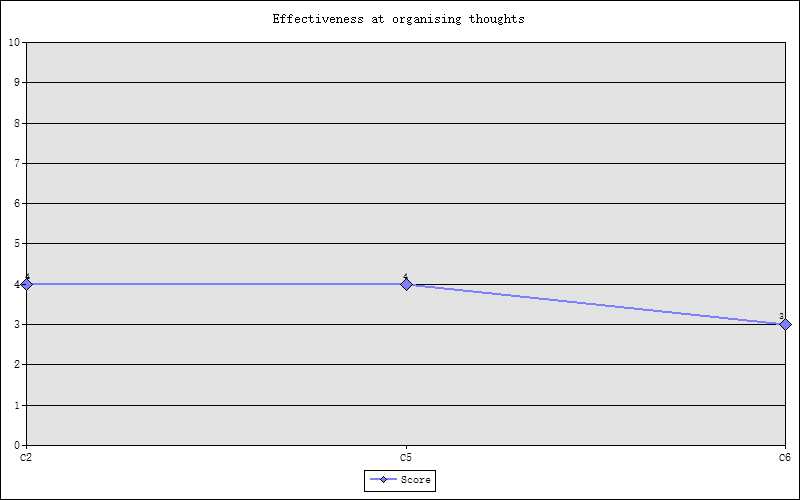
C2(ORDER)4——Average
High scorers on this scale are neat, tidy, and well-organized. They keep things in their proper places. Low scorers are unable to get organized and describe themselves as unmethodical.
C5(SELF-DISCIPLINE)4——Average
High scorers are able to begin tasks and carry them through to completion, despite boredom or other distractions. They can motivate themselves to get the job done. Low scorers procrastinate in beginning chores and are easily discouraged and eager to quit.
C6(DELIBERATION)3——Low
Deliberation reflects the tendency to think carefully before acting. High scorers on this facet are cautious and deliberate. Low scorers are hasty and often speak or act without considering the consequences. At best, low scorers are spontaneous and able to make snap decisions when necessary.
|
|
②Open-mindedness and originality |
|
|
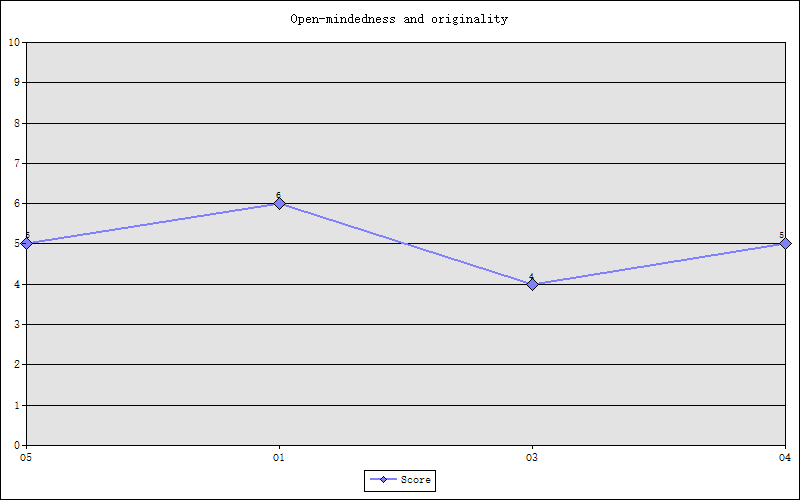
O5(IDEAS)5——Average
Intellectual curiosity is an aspect of Openness that has long been recognized. This trait is seen not only in an active pursuit of intellectual interests for their own sake, but also in open-mindedness and a willingness to consider new, perhaps unconventional, ideas. High scorers enjoy both philosophical arguments and brain teasers. Openness to ideas does not necessarily imply high intelligence, though it can contribute to the development of intellectual potential. Low scorers on the scale have limited curiosity and, if highly intelligent, narrowly focus their resources on limited topics.
O1(FANTASY)6——Average
Individuals who are open to fantasy have a vivid imagination and an active fantasy life. They daydream not simply as an escape, but as a way of creating an interesting inner world for themselves. They elaborate and develop their fantasies and believe that imagination contributes to a rich and creative life. Low scorers are more prosaic and prefer to keep their minds on the task at hand.
O3(FEELINGS)4——Average
Openness to feelings implies receptivity to one's own inner feelings and emotions and the evaluation of emotion as an important part of life. High scorers experience deeper and more differentiated emotional states and feel both happiness and unhappiness more keenly than others do. Low scorers have somewhat muted affects and do not believe that feeling states are of much importance.
O4(ACTIONS)5——Average
Openness is seen behaviorally in the willingness to try different activities, go to new places, or eat unusual foods. High scorers on this scale prefer novelty and variety to familiarity and routine. Over time, they may engage in a series of different hobbies. Low scorers find change difficult and prefer to stick with the tried-and-true. |
|
③Confidence in problem-solving |
|
|
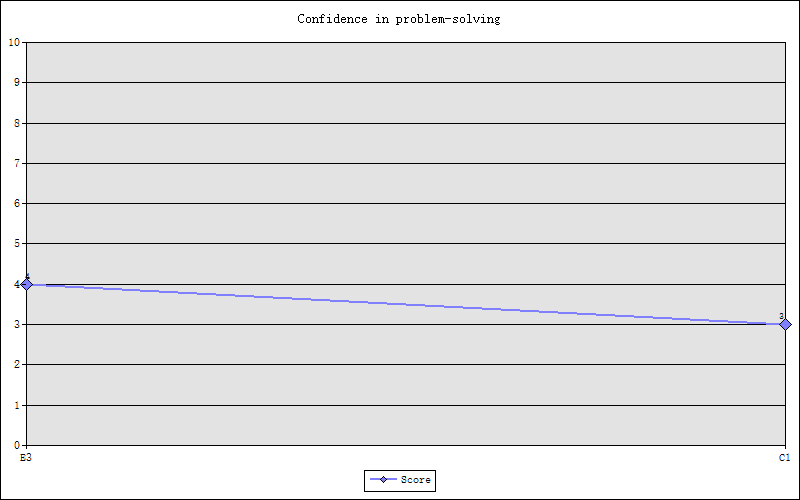
E3(ASSERTIVENESS)4——Average
High scorers on this facet are dominant, forceful, and socially ascendant. They speak without hesitation and often become group leaders. Low scorers prefer to keep in the background and let others do the talking.
C1(COMPETENCE)3——Low
Competence refers to the sense that one is capable, sensible, prudent, and effective. High scorers on this scale feel well-prepared to deal with life. Low scorers have a lower opinion of their abilities and admit that they are often unprepared and inept.
|
⑵Planning, organising and implementing
This section explores your operational style: how you go about determining an action plan and implementing it.
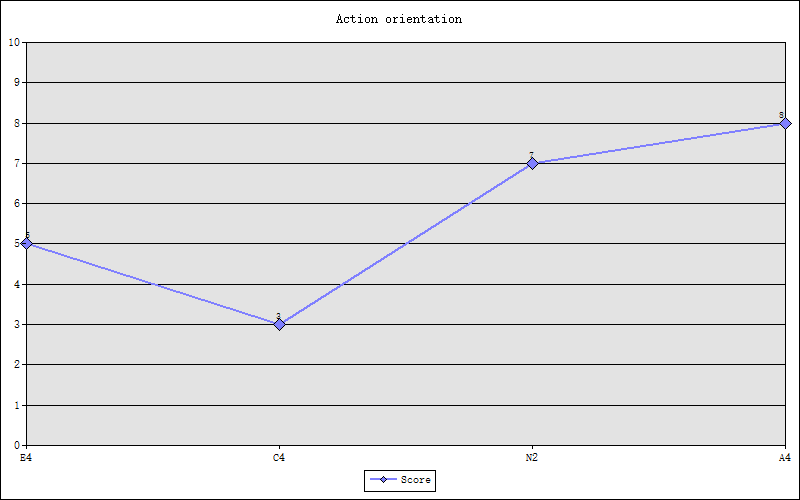
E4(ACTIVITY)5——Average
A high Activity score is seen in rapid tempo and vigorous movement, a sense of energy, and a need to keep busy. Active people lead fast-paced lives. Low scorers are more leisurely and relaxed in tempo, though they are not necessarily sluggish or lazy.
C4(ACHIEVEMENT STRIVING)3——Low
Individuals who score high on this facet have high aspiration levels and work hard to achieve their goals. They are diligent and purposeful and have a sense of direction in life. Very high scorers, however, may invest too much in their careers and become workaholics. Low scorers are lackadaisical and perhaps even lazy. They are not driven to succeed. They lack ambition and may seem aimless, but they are often perfectly content with their low levels of achievement.
N2(ANGRY HOSTILITY)7 ——High
Angry hostility represents the tendency to experience anger and related states such as frustration and bitterness. This scale measures the individual's readiness to experience anger; whether the anger is expressed depends on the individual's level of Agreeableness. Note, however, that disagreeable people often score high on this scale. Low scorers are easy-going and slow to anger.
A4(COMPLIANCE)8 ——High
This facet of Agreeableness concerns characteristic reactions to interpersonal conflict. The high scorer tends to defer to others, to inhibit aggression, and to forgive and forget. Compliant people are meek and mild. The low scorer is aggressive, prefers to compete rather than to cooperate, and has no reluctance to express anger when necessary.
|
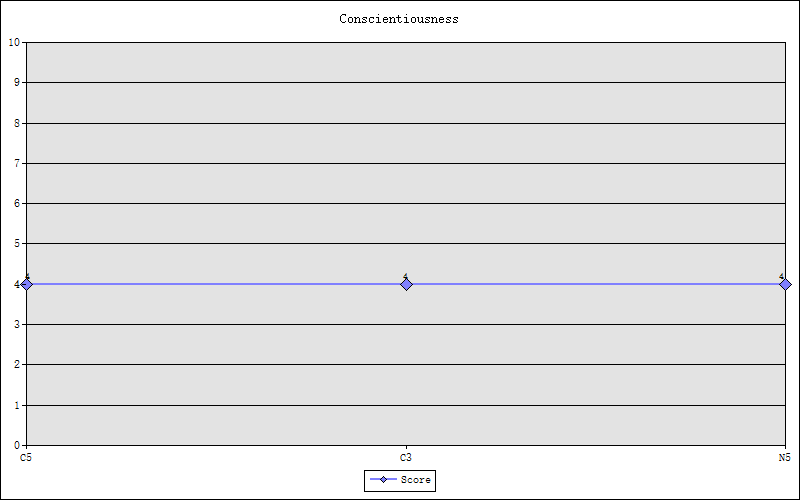
C5(SELF-DISCIPLINE)4——Average
High scorers are able to begin tasks and carry them through to completion, despite boredom or other distractions. They can motivate themselves to get the job done. Low scorers procrastinate in beginning chores and are easily discouraged and eager to quit.
C3(DUTIFULNESS)4——Average
High scorers on this scale adhere strictly to their ethical principles and scrupulously fulfill their moral obligations as they understand them. Low scorers are more casual about such matters and may be somewhat undependable or unreliable.
N5(IMPULSIVENESS)4——Average
Impulsiveness refers to the inability to control cravings and urges. Desires (e.g., for food, cigarettes, possessions) are perceived as being so strong that the individual cannot resist them, although he or she may later regret the behavior. Low scorers find it easier to resist such temptations and have a high tolerance for frustration. The Impulsiveness facet should not be confused with spontaneity, risk-taking, or rapid decision time.
|
|
③Openness to possibilities and alternatives |
|
|
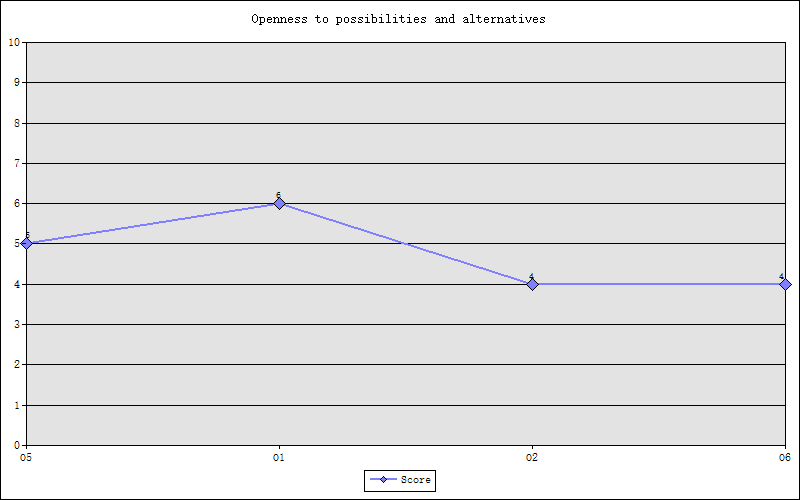
O5(IDEAS)5——Average
Intellectual curiosity is an aspect of Openness that has long been recognized. This trait is seen not only in an active pursuit of intellectual interests for their own sake, but also in open-mindedness and a willingness to consider new, perhaps unconventional, ideas. High scorers enjoy both philosophical arguments and brain teasers. Openness to ideas does not necessarily imply high intelligence, though it can contribute to the development of intellectual potential. Low scorers on the scale have limited curiosity and, if highly intelligent, narrowly focus their resources on limited topics.
O1(FANTASY)6——Average
Individuals who are open to fantasy have a vivid imagination and an active fantasy life. They daydream not simply as an escape, but as a way of creating an interesting inner world for themselves. They elaborate and develop their fantasies and believe that imagination contributes to a rich and creative life. Low scorers are more prosaic and prefer to keep their minds on the task at hand.
O2(AESTHETICS)4——Average
High scorers on this scale have a deep appreciation for art and beauty. They are moved by poetry, absorbed in music, and intrigued by art. They need not have artistic talent, nor even necessarily what most people would consider good taste, but for many of them, their interest in the arts will lead them to develop a wider knowledge and appreciation than that of the average individual.
O6(VALUES)4——Average
Openness to Values assesses the readiness to reexamine social, political, and religious values. Closed individuals tend to accept authority and to honor tradition and, as a consequence, are generally conservative, regardless of political party affiliation. Openness to Values may be considered the opposite of dogmatism.
|
⑶Style of relating to others
This section explores how you interact with others in terms of both your emotional orientation to other people and the role you adopt in your interpersonal relationships. No value judgements are made about your style of working with others. It is accepted that a style that proves to be an asset in one situation may prove to be a liability in another. It is up to you to reflect on how your style influences the quality of your relationships in your current life situation.
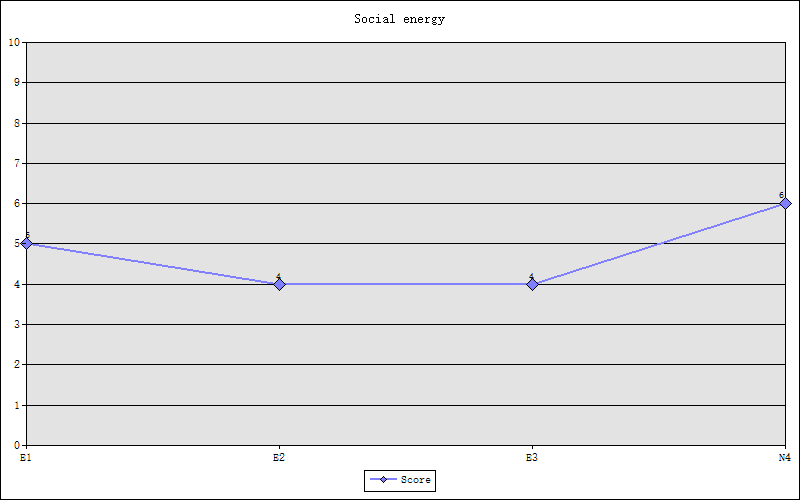
E1(WARMTH)5——Average
Warmth is the facet of Extraversion most relevant to issues of interpersonal intimacy. Warm people are affectionate and friendly. They genuinely like people and easily form close attachments to others. Low scorers are neither hostile nor necessarily lacking in compassion, but they are more formal, reserved, and distant in manner than high scorers.
E2(GREGARIOUSNESS)4——Average
Gregarious people enjoy the company of others – "the more the merrier." Low scorers on this scale tend to be loners who do not seek – or who even actively avoid – social stimulation.
E3(ASSERTIVENESS)4——Average
High scorers on this facet are dominant, forceful, and socially ascendant. They speak without hesitation and often become group leaders. Low scorers prefer to keep in the background and let others do the talking.
N4(SELF-CONSCIOUSNESS)6——Average
The emotions of shame and embarrassment form the core of this facet of Neuroticism. Self-conscious individuals are uncomfortable around others, sensitive to ridicule, and prone to feelings of inferiority. Self-consciousness is akin to shyness and social anxiety. Low scorers do not necessarily have poise or good social skills, they are simply less disturbed by awkward social situations. |
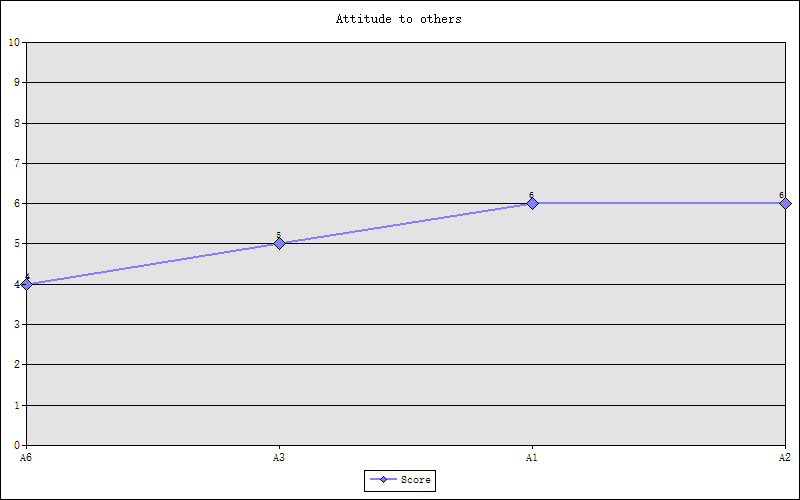
A6(TENDER-MINDEDNESS)4——Average
This facet scale measures attitudes of sympathy and concern for others. High scorers are moved by others' needs and emphasize the human side of social policies. Low scorers are more hardheaded and less moved by sympathetic appeals to pity. They would consider themselves realists who make rational decisions based on cold logic.
A3(ALTRUISM)5——Average
High scorers on the Altruism scale have an active concern for others' welfare as shown in generosity, consideration of others, and a willingness to assist others in need of help. Low scorers on this scale are somewhat more self-centered and are reluctant to get involved in the problems of others.
A1(TRUST)6——Average
High scorers are disposed to believe that others are honest and well-intentioned. Low scorers on this scale tend to be cynical and skeptical and to assume that others may be dishonest or dangerous.
A2(STRAIGHTFORWARDNESS)6——Average
Individuals with high scores on this scale are frank, sincere, and ingenuous. Low scorers on this scale are more willing to manipulate others through flattery, craftiness, or deception. They view these tactics as necessary social skills and may regard more straightforward people as naïve. A low scorer on this scale is more likely to stretch the truth or to be guarded in expressing his or her true feelings, but this should not be interpreted to mean that he or she is a dishonest or manipulative person.
|
|
③Quality of relationships |
|
|
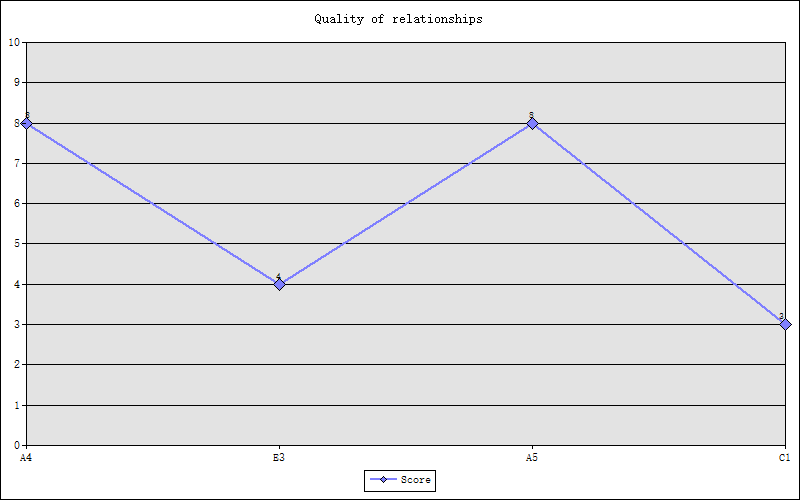
A4(COMPLIANCE)8 ——High
This facet of Agreeableness concerns characteristic reactions to interpersonal conflict. The high scorer tends to defer to others, to inhibit aggression, and to forgive and forget. Compliant people are meek and mild. The low scorer is aggressive, prefers to compete rather than to cooperate, and has no reluctance to express anger when necessary.
E3(ASSERTIVENESS)4——Average
High scorers on this facet are dominant, forceful, and socially ascendant. They speak without hesitation and often become group leaders. Low scorers prefer to keep in the background and let others do the talking.
A5(MODEST)8 ——High
High scorers on this scale are humble and self-effacing, though they are not necessarily lacking in self-confidence or self-esteem. Low scorers believe they are superior people and may be considered conceited or arrogant by others.
C1(COMPETENCE)3——Low
Competence refers to the sense that one is capable, sensible, prudent, and effective. High scorers on this scale feel well-prepared to deal with life. Low scorers have a lower opinion of their abilities and admit that they are often unprepared and inept.
|
⑷Personal style
Each of us has a unique emotional signature to our personality. In this section, we explore your emotions and general outlook on life
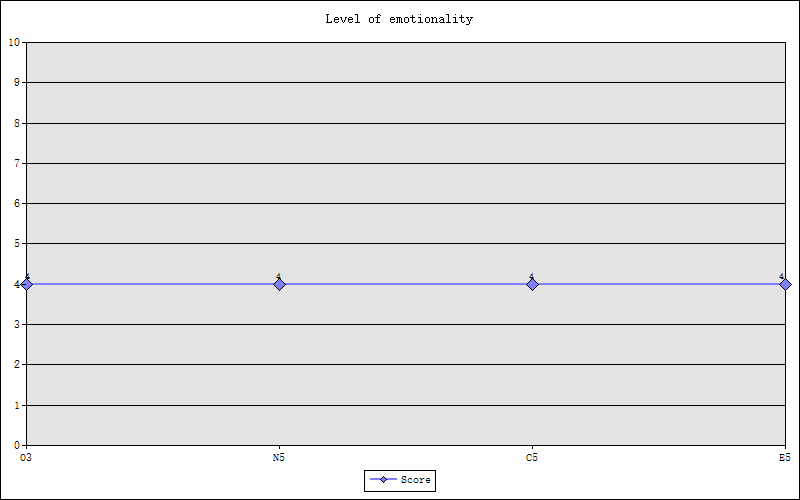
O3(FEELINGS)4——Average
Openness to feelings implies receptivity to one's own inner feelings and emotions and the evaluation of emotion as an important part of life. High scorers experience deeper and more differentiated emotional states and feel both happiness and unhappiness more keenly than others do. Low scorers have somewhat muted affects and do not believe that feeling states are of much importance.
N5(IMPULSIVENESS)4——Average
Impulsiveness refers to the inability to control cravings and urges. Desires (e.g., for food, cigarettes, possessions) are perceived as being so strong that the individual cannot resist them, although he or she may later regret the behavior. Low scorers find it easier to resist such temptations and have a high tolerance for frustration. The Impulsiveness facet should not be confused with spontaneity, risk-taking, or rapid decision time.
C5(SELF-DISCIPLINE)4——Average
High scorers are able to begin tasks and carry them through to completion, despite boredom or other distractions. They can motivate themselves to get the job done. Low scorers procrastinate in beginning chores and are easily discouraged and eager to quit.
E5(EXCITEMENT SEEKING)4——Average
High scorers on this scale crave excitement and stimulation. They like bright colors and noisy environments. Excitement-Seeking is akin to some aspects of sensation seeking. Low scorers feel little need for thrills and prefer a lifestyle that high scorers might find boring.
|
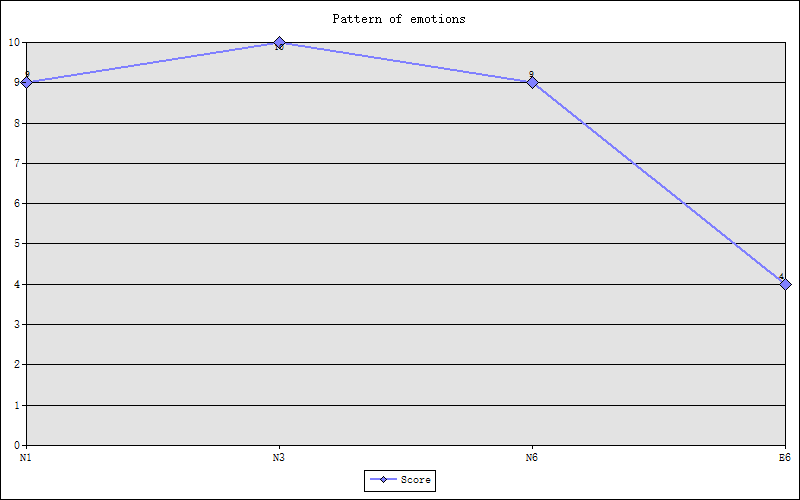
N1(ANXIETY)9 ——High
Anxious individuals are apprehensive, fearful, prone to worry, nervous, tense, and jittery. The scale does not measure specific fears or phobias, but high scorers are more likely to have such fears, as well as free-floating anxiety. Low scorers are calm and relaxed. They do not dwell on things that might go wrong.
N3(DEPRESSION)10 ——High
This scale measures individual differences in the tendency to experience depressive affect. High scorers are prone to feelings of guilt, sadness, hopelessness, and loneliness. They are easily discouraged and often dejected. Low scorers rarely experience such emotions, but they are not necessarily cheerful and lighthearted – characteristics associated instead with Extraversion.
N6(VULNERABILITY)9 ——High
Individuals who score high on this scale feel unable to cope with stress, becoming dependent, hopeless, or panicked when facing emergency situations. Low scorers perceive themselves as capable of handling themselves in difficult situations.
E6(POSITIVE EMOTIONS)4——Average
The last facet of Extraversion assesses the tendency to experience positive emotions such as joy, happiness, love, and excitement. High scorers laugh easily and often. They are cheerful and optimistic. Low scorers are not necessarily unhappy; they are merely less exuberant and high-spirited.
|